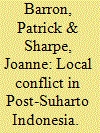|
|
|
Sort Order |
|
|
|
Items / Page
|
|
|
|
|
|
|
| Srl | Item |
| 1 |
ID:
084039


|
|
|
|
|
| Publication |
2008.
|
| Summary/Abstract |
Recent scholarship on communal violence in Indonesia since the late New Order has focused on identifying causal mechanisms of particular subtypes of communal violence such as large-scale communal violence, town-level communal rioting, intervillage violence, and lynching. While such analyses are useful in understanding aspects specific to each subtype of violence, analyzing each subtype separately risks the analytical problem of selection on the dependent variable if there are important similarities across subtypes. Drawing on the observation that each of these subtypes appeared to rise and fall together since the late New Order, I propose a common factor that can explain the broad temporal patterns of communal violence. In particular, I point to increasing restraints on the military that arose from intraregime infighting, greater scrutiny of military actions during the keterbukaan (political openness) period, and the withdrawal of the military from police duties during Reformasi. I examine four cases of communal conflict: (1) a case in which intravillage violence was averted, (2) a case of lynching, (3) a case of lynching and subsequent intervillage reprisals, and (4) a case of large-scale communal violence. The first three cases are from Lampung province, and the fourth is the case of Poso district, Central Sulawesi.
|
|
|
|
|
|
|
|
|
|
|
|
|
|
|
|
| 2 |
ID:
084037


|
|
|
|
|
| Publication |
2008.
|
| Summary/Abstract |
Responding to conflict, in Indonesia and elsewhere, requires an understanding of its distribution, forms, and impacts. In this article, we outline an attempt to use local newspaper monitoring to measure the levels and impacts of violent conflict during the period 2001-2003 in two Indonesian provinces (East Java and NTT). We also assess variation in incidence, impact, and form across and within areas. The study data suggest first that previous research has vastly underestimated the impacts of violent conflict in Indonesia. Comparing our data with those of the previous attempt to use newspapers to map conflict in Indonesia (by the UN Support Facility for Indonesian Recovery [UNSFIR]), we find three times as many deaths from collective violence. These differences are a function of the level of news sources used, with provincial papers picking up only a small proportion of deaths in our research areas. Further, we argue that the impacts of certain types of violence between individuals should be included, leading to even higher figures. Second, our data call into question the dictum that violence in Indonesia is concentrated in a small number of regions. While there is variation between districts, we record large impacts from collective violence in areas not previously considered conflict-prone. Third, substantial variations in conflict form are found across regions, and these result in different kinds of impacts. This underlines the importance of consideration of the role of local factors in driving conflicts and suggests that approaches must be tailored to local conditions. Finally, we demonstrate that using local newspapers to measure and analyze conflicts presents a useful tool for understanding conflict in Indonesia. The use of subprovincial news sources captures more accurate estimates of conflict incidence than other methods, such as provincial newspaper mapping or surveying. It can also provide a basis for a deeper understanding of variations in patterns of conflict across areas and provide insights into how we might respond.
|
|
|
|
|
|
|
|
|
|
|
|
|
|
|
|
|
|
|
|
|